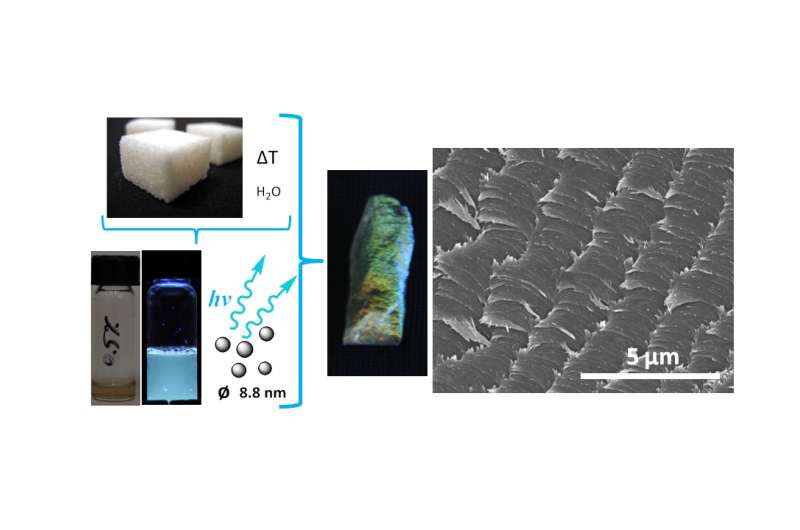Researchers use carbon nanoparticles from cellulose as sensor material

By synthesizing carbon nanoparticles from sugar and a source of cellulose such as newspapers, researchers in the UPV/EHU's Department of Physical Chemistry have developed a material that could be used as a sensor as its components respond to stimuli. For example, the fluorescence of carbon nanoparticles has been found to increase or diminish in the presence of different metals, so they could be used as materials for detection.
Erlantz Lizundia, a researcher in the UPV/EHU's department of Physical Chemistry and expert in cellulose, started the research in Canada. The research group with which he participated specialised in the helix-shaped organisation of a product extracted from cellulose—cellulose nanocrystals (CNCs).
Under specific conditions, the crystals can assume a helical structure, or assume chiral nematic structures when the crystals are organised into ordered layers. Membranes with unique properties can thus be obtained: "The membrane displays a different colour depending on the distance existing between the layers of cellulose nanocrystals that form the helical, or chiral nematic structure. An interaction takes place between the structure and the light and, as a result, the wavelength of the light changes and materials in bright colours are obtained," said Lizundia. This capacity to change colour displayed by the structure "could prove very useful in enabling these membranes to be used as sensors. For example, when they are put into a humid environment, the structure will swell and the distance between the layers will increase and the colour will change," he said. This effect is known as structural coloration, and is very common in nature. The colour of a whole host of animals (snakes, chameleons) and plants is the direct consequence of their supramolecular structure, and contrary to belief, the phenomenon is not linked to the presence of pigments.
Inserting carbon dots into the chiral nematic structure of the cellulose nanocrystals makes this material particularly suited as a detector for the presence of iron. Lizundia says, "It is very useful for detecting environmental pollution or the presence of metals in the body. I studied the material's response to zinc and iron, as they are both present in large quantities in environmental and biological matter. I was able to see that the interaction of the metal ions with the carbon nanoparticles influences the degree of fluorescence emitted by the nanoparticles. The fluorescence diminishes in the presence of iron, whereas it increases in the presence of zinc."
Another possible application of this material could be in bioimaging. "I will shortly be embarking on research to go further into this subject and use these nanoparticles to create bioimages," Lizundia says. Bioimaging consists of creating images using non-invasive methods in biological processes, such as cell processes, as well as measuring the interaction between molecules in real time in the location where these interactions are taking place.
More information: Erlantz Lizundia et al, Chiroptical luminescent nanostructured cellulose films, Mater. Chem. Front. (2017). DOI: 10.1039/C6QM00225K
Provided by University of the Basque Country





















